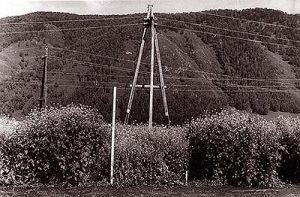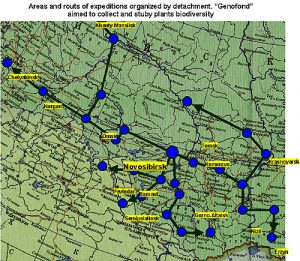Institute of Cytology and Genetics, SB RAS, Novosibirsk
Head of the Institute:
Vladimir K.Shumny, Academician of the RAS
10 Lavrentiev Ave., Novosibirsk, 630090, Russia
Tel.: +(383-2) 33-35-26
Fax: +(383-2) 33-12-78, 33-34-66
email: shumny@bionet.nsc.ru
Principal researchers:
A.V.Jheleznov, Ph.D., Head of the Group of Plant Genetic Diversity
Project objectives
The goal of the project is to develop the database on forage and medicinal wild plants of Western Siberia and Altai (DAVSWP). The diversity of valuable in the context of man species populated in Western Siberia and Altai will be described in this database. All samples described will be maintained in vivo in genetic collections. Both database and genetic collections will be further enrished and developed by expeditions in different regions of Western Siberia and Altai. For genetic structure of populations to be presented more completely, seed are collected from 300-500 plants in each population. Further seeds are sown in Novosibirsk for sample evaluations. All data on.morphological, biochemical, cytological and other characters will be accumulated in database. Thus, plant diversity in Western Siberia and Altai will be describe in database at population and species level.
Background and significance of objectives
At modern stage of biodiversity research an инвентаризации is the most actual. It is known that biodiversity is decreasing under pressure of intensively rising antropogenic factors. The conservation of biodiversity becomes to be another actual biodiversity problem. One of the conservation approach is to store seeds in gene banks.
Creation of this bank is one of our goals. Every year from 1984 we had expeditions to collect samples of wild species in East Siberia and Kazakhstan. Map of this expeditions is shown in Fig. 1. Now data bank contains data on 8000 samples of 125 species. Our collection differs from other other collections which goaled to decribe large territories with small number of samples from definite regions. The biodirversity of definite regions in some territories is presented in our collection as full as possible. These regions are the following: Mountain Altai, Aleisk-Rubcovsk stip, Ob stip, Kulunda lake zone, South Ural and others (Fig. 1).
Populations of the following species and genera have been studied in this regions: Dactilys glomerata, Bromopsis inermis, Medicago, Trifolium, Amaranthus, Agropyron and other species typical for these regions. Screening of 180 alfalfa samples including wild grasses and local varieties revealed their diversity in different characters. For example, samples with high and law salt resistance.
The intrapopulation variability of some луговых plant species in their ability to accumulate strontium 90 showed that there is not only interspecific but also intraspecific diversity in this character It was shown that populations consist of plants which level of strontium accumulation can differ in 2-37 times and it has genetic control.
Studies of the karyological polymorphism in wild populations and cultivars of smooth brome from different geographical locations have demonstrated that octaploid forms dominate in the majority of locations. It is likely that these octaploid forms result from cross-pollination of different representatives of the genus Bromopsis L. with subsequent duplication of the chromosome number. However, we found tetraploid forms with 28 chromosomes in Gorni Altai and Chita region.
Analysis of sweet clover populations (Melilotus L.) for the coumarin content in the vegetative tissues has revealed a considerable interspecific variation of this trait. The highest coumarin content (2.2%) was found in bitter meliot (M. indica All.), whereas only residual amount of coumarin was detected in dentated meliot (M. dentata Plos.). The rest 15 species displayed intermediate coumarin content. However, the interpopulation variation of this trait was insignificant and amounted to 1.2—2.2%.
A considerable polymorphism of the seed storage protein composition in the genus Agropyron was demonstrated by the example of crested wheatgrass (A. cristatum L.).
Thus, the data obtained represent the actual diversity of plant forms in a variety of traits and demonstrate that studies of polymorphism of wild populations allows the variation limits to be determined, or according to N.I. Vavilov, the species differential to be assessed. This, in turn, allows donors of agriculturally important traits to be isolated. We have isolated salt tolerant alfalfa forms, several sweet clover species with exclusively low coumarin content, foliose forms of tetraploid smooth brome, and others, and they are among such potential donors. The discovered polymorphism in the capability of accumulating strontium-90 brought forward the problem of selecting the plants for this trait. Clear-cut data on the levels of intra- and interspecific polymorphism in the capability of radionuclide accumulation will allow the contrast plant forms to be isolated and genetics of the plants efficiently and inefficiently accumulating radionuclides to be studied.
The other side of this work is accumulation of the data demonstrating the actual diversity of plant forms within individual species. Addition of these data into the total informational pool on biological diversity will aid the development of this direction.
The territory of Western Siberia houses over 2000 plant species, including valuable aboriginal endemics and rare plants related to cultivated plants. Moreover, as numerous populations, ecotypes, and edaphic forms represent each species, it determines the large scale of the work to be done. Therefore, the accession of new specimens to our collection will aid both the preservation of these valuable species and study of their diversity and even their possible commercial cultivation.
The evolutionary aspect of intraspecific diversity is also very important. Variation, polymorphism, ecological and geographical forms and stocks are simultaneously the material for and the result of adaptive and microevolutionary processes, considered conventionally relative to species formation. Another function of the intraspecific diversity as a factor of evolutionary stability of species is also evident. This function of intraspecific heterogeneity is still inadequately studied. Therefore, it would be reasonable to study different populations of one species under comparable growth conditions, in particular, under experimental field conditions. Such study would give the information on morphological, phenological, biochemical, and cytological parameters of these populations, on limits of their variation, and adaptive reactions to growth conditions. It would also allow both breeders and specialists on biological diversity problems to determine the potential of their gene pools for the tasks related with their particular interest. We represent the only research group in Siberia that is performing large-scale studies of biological diversity.
Numerous specimens of different wild plant species are studied, and each is provided with a certificate. For each of the wild species in our collection, we have developed a specialized format describing its biological diversity. It is not just the lack of unification for all the species. On the contrary, specialized formats for each species allows their biological diversity to be described most precisely. On the other hand, standardization of the description procedure allows the material to by systematized. Each species is supplied with the certificate according to the format developed, and the data from the certificate are compiled in the Internet-available database. This database will allow the interested users to get the information not only on various characteristics of populations and species, but also to order seeds from the genetic bank. Each user will be able to use the data and seeds according to his own interests for solving theoretical and applied problems of biology, genetics, and breeding.
Research plan: approaches and methods
Work with genetic resources implies a series of stages, where each previous stage initiates the next one or affects it. J. Hawkes (1991) called this process the sequence of associated actions. Let’s name them:
- Forming of collections;
- Specimen estimation;
- Identification and certification of the specimens;
- Maintenance of the collection; and
- Accumulation of the data on geographical distribution of each specimen, its species and population composition, and various characteristics in the database (DAVSWP).
Collection is formed by seed sampling of the wild flora of the Western Siberia and Altai. For seed collecting, expeditions are organized to different regions. Phytoceonsis and ecological conditions are described while seed collecting as well as the geographical coordinates of each particular site where a specimen collected was growing.
The material collected is planted on experimental plots for further reproduction and estimation. Estimation of the specimens is carried out both in field and laboratory by conventional techniques. The estimations obtained are used to fill in the specimen’s certificate. The certificate data are inputted into the database.
Expected results
As a result of the work proposed, the computer database on valuable wild feeder plants and medicinal herbs growing in the Western Siberia and Altai (DAVSWP) will be created. This database will reflect the diversity of plant species valuable from human standpoint on the territory of Western Siberia and Altai. All the plant species represented in the database will be stored in vivo in continuously maintained genetic collections.
Species composition of the plants studied will be described with a complete characterization of their genetic variability, and each population will be characterized according to many parameters. For example, we can not only determine the number of clover (Trifolium) species on the territory of Tumen region, but also describe qualitatively and quantitatively the populations of this genera.
Collections of the main wild plant species growing on the territories of Western Siberia and Altai and valuable from agricultural or medical standpoints will be formed. Estimates characterizing diversity of plant populations will be obtained at morphological, biochemical, cytological and genetic levels.
List of publications of participants related to the project
-
Zheleznov A.V., Osipova G.M., Zheleznova N.B. Polyploidy in smooth brome and its application in breeding // Sel’skokhozyaistvennaya Biologiya, 1982. – Vol. 27, № 3. – P. 315-320.
-
Zheleznov A.V., Buturulina O.F. Study of the collection of smooth brome under the conditions of near-Ob forest steppe // Science-Technology Bulletin. – Novosibirsk: Izd. SO VASKhNIL, 1982. – № 43-44. – P. 22-29.
-
Zheleznov A.V., Deineko E.V. Polymorphism of coumarin content in biennial sweet clover populations // Sel’skokhozyaistvennaya Biologiya. – 1983. – № 2. – P. 39-40.
-
Zheleznov A.V., Goryacheva N.D. Study of salt tolerance in alfalfa, Sibirskii Vestnik Sel’slokhozyaistvennoi Nauki. – 1983. – № 2. – P. 45-48.
-
Smetanin N.I., Zheleznov A.V., Shumny V.K. Population structure of alfalfa and sweet clover according to the nitrogen fixation level // Initial Material and Methods in Alfalfa Breeding under High Farming. – Alma-Ata, 1984. – P. 148-156.
-
Zheleznov A.V., Zheleznova N.B., Kolosova L.D. Experience in creation and maintenance of plant gene pool under midlevel Altai conditions // Biocenoses of Altai Krai and How They Are Affected by Anthropogenic Conditions – Barnaul, 1990. – P. 24-27.
-
Zheleznov A.V., Kolosova L.D., Zheleznova N.B. Results of the studies of spring barley collection, Selektsiya i Semenovodstvo. – 1990. – № 3. – P. 24-25.
-
Zheleznov A.V., Solonenko L.P., Zheleznova N.B., Khapunova N.F. Study of plant chemical composition of different amaranth species // Genetic Bases of Plant Productivity Traits – Novosibirsk, 1992. – P. 39-63.
-
Zheleznov A.V., Zheleznova N.B. Problems of preserving and applying plant genetic plant genetic resources // Plant Genetic Collections. – Novosibirsk, 1994. – P. 6-32.
-
Zheleznov A.V., Zheleznova N.B., Shumny V.K. Siberian gene pool of feeder plants and medicinal herbs: creation and study // Sibirskii Ekologicheskii Zhurnal. – 1994. – № 1. – P. 67-74.
-
Goryachkovskaya T.N., Zheleznov A.V, Zheleznova N.B., Pel’tek S.E. Storage protein polymorphism in populations of crested wheatgrass Agropyron cristatum L. // Genetika. – 1995. – Vol. 31, № 1 – P. 68-71.
-
Zheleznov A.V., Solonenko L.P., Zheleznova N.B. Genetic diversity of orchard grass populations (Dactilys glomerata L.) from meadowy phytocenoses of Western Siberia and Altai // Modern Concepts of Evolutionary Genetics. – Novisibirsk, 1997. – Part 1. – P. 101-104.
-
Zheleznov A.V., Zheleznova N.B., Leonova N.V. Siberian gene pool of feeder plants and medicinal herb // Scientific and Applied Development: IC&G Anniversary Issue. – Novosibirsk, 1997. – P. 36-38.
-
Zhelesnov A.V., Solonenko L.P., Zhelesnova N.B. Seed proteins of the wild and cultivated Amaranthus species.// Euphytica. – 1997. – Vol. 97, № 2. – P. 177-182.


